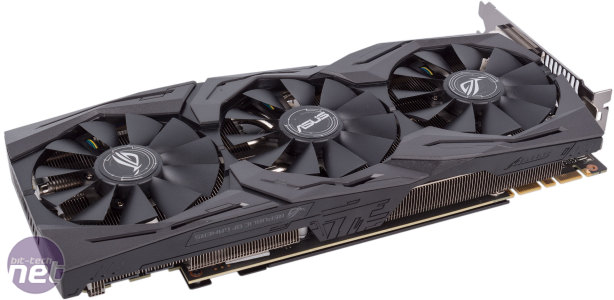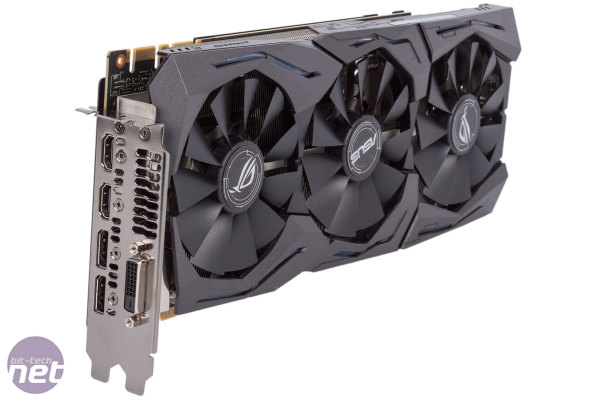
Performance Analysis
It's of course not surprising to see strong performance numbers across the board. The GTX 1080 Strix OC doesn't hold a major advantage over the EVGA GTX 1080 FTW (the numbers for which are based on a slightly older driver revision, we should point out) but it does come out as 2 percent faster on average – certainly nothing you'll notice, but faster nonetheless. As ever, it has a hefty lead on AMD's closest card, the R9 Fury X.1440p is no problem, with all minimum frame rates well into the smooth gameplay territory – this is the resolution that the card is most suited to for Ultra settings. At 4K, it is doable, as four of the six game result show decent figures, but the 20fps and 28fps minimum frame rates in The Division and Fallout 4 respectively do show that certain Ultra settings will be to punishing for this resolution. That said, Very High or the equivalent is often almost as good as Ultra but less punishing – it's still possible to have a good 4K gaming experience with this card if you're happy having most, but not quite all, of the detail sliders at maximum.
Power consumption in OC Mode is in line with the EVGA card and another reminder of Pascal's efficiency, with our entire system consuming less than 400W. Consumption does actually drop as you move to the slower modes, but we still think your best bet is to just stick with OC Mode. In this state, the card was boosting to about 1,975MHz on average, dropping to between 1,900MHz and 1,950MHz in Gaming Mode and finally to between 1,800MHz and 1,860MHz in Silent Mode.
The DirectCU III cooler is extremely effective on this GPU, keeping it at a delta T of just 47°C. To do so, the fans peaked at 53 percent (just over 1,900RPM), which is naturally a bit higher than on the GTX 1070 Strix. At this speed, they are clearly audible but not whiny or intrusive. Silence enthusiasts will want to tweak the fan profile to reduce the noise output, we imagine, but given how well the cooler performs there's clearly lots of headroom to do this without worrying about much of an impact on boost speeds.
While we weren't able to add much to the core, we did still see some performance improvements thanks to the increased power limit and memory speed. The card was boosting to between 2,000MHz and 2,025MHz mostly, and while we have seen other GTX 1080s go higher it's really just luck of the draw – anything over 2,000MHz is a good result, while 2,100Mhz appears to be about the upper limit for these GPUs on air. It's also reassuring to know that Asus is already running this card very close to its limits – when you're paying top dollar, this is what you would hope for.
Conclusion
The Strix brand makes a lot of sense when applied to the GTX 1080: it's a premium brand for a premium GPU. Certainly, not every GTX 1080 buyer needs to go for a top-of-the-line model, but customers looking at GTX 1080s are certainly the sort likely to be drawn towards fancy features like RGB lighting, FanConnect, bolstered power circuitry and a significantly upgraded cooler. We also like the VR-friendly display outputs and the 100 percent automated construction process may add to your sense of trust in the product's quality and reliability too. For anyone looking to build a killer VR or high res gaming rig, this card would be a great fit sure to make many envious.The near-£200 (about 33 percent) markup over basic models is really rather substantial and as usual you can definitely do better than this if you're shopping from a bang per buck perspective - Asus itself has a number of lower priced SKUs. The presence of the GTX 1080 Strix Advanced suggests the binning process of GPUs hasn't been quite as kind to Asus as it might have liked, and when less chips make the cut that also pushes up the price. In fairness, Asus really does seem to be running this card close to its limits, and having that guaranteed high overclock will definitely appeal to those really looking for the best of the best. Still, some form of memory overclock would be nice, as would a longer warranty, but there's no denying the quality of what Asus has here. Remember, if you like what you see but don't want to stretch your budget this far, the standard Strix or the Strix Advanced are also viable, cheaper options, and we'd wager most would be able to reach clock speeds similar to what this card offers, but of course this isn't guaranteed like it is here.


MSI MPG Velox 100R Chassis Review
October 14 2021 | 15:04










Want to comment? Please log in.